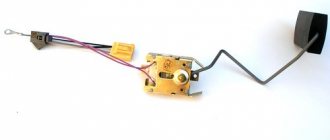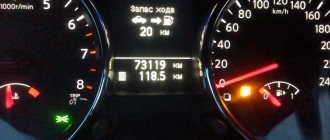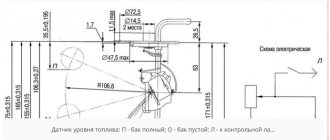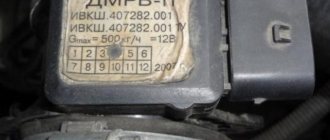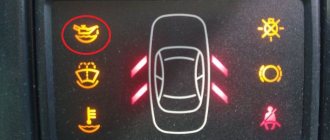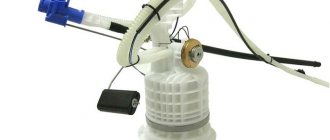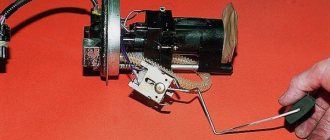Every motorist knows that the fuel level sensor on the injection VAZ 2110 plays its irreplaceable role on the dashboard. How else will you determine how much fuel you have left in the tank?!
When it comes to driving around the city, you don’t have to pay much attention to this, since there is always some gas station nearby. Traveling outside the city, where gas stations occur every few tens or even hundreds of kilometers, is a very risky activity in the case when the measuring element does not work.
What is a fuel sensor
The fuel level sensor (FLS) is a control and measuring device that transmits information about the amount of fuel to the dashboard to the fuel level indicator (FLI), located on the dashboard next to the speedometer.
The operating principle of the FLS is simple: the fuel sensor is built into the gas tank system, consisting of a check valve, filter and fuel pump. A similar fuel supply and control system is used in injection engines. It is built into the gas tank cap and screws in with it.
This device is typical for diesel engines and is installed on the side as a separate unit. In this case, a float with a lever for tubular devices is placed inside the tank, and the movement of the latter determines the level of fuel in the tank.
FLS device
In modern cars, LENs are installed mainly of lever and tubular types. In general, their operating principle has a lot in common, although upon closer examination some differences can be found between them. The VAZ 2110 is equipped with proven lever sensors. They are reliable, give a small error, but periodically fail. Sometimes their service life can be extended with simple manipulations, but sooner or later it becomes necessary to completely replace the VAZ 2110 fuel level sensor.
The figure shows a diagram of the VAZ 2110 fuel level sensor.
Article: 24.3827, additional articles: 2108-3827010.01/20, 2108-3827010
Order code: 000637
- You may need
- show more
Fuel level indicator sensor with reserve fuel level indicator
- Rated voltage -12 V
- Lever radius - 114 mm
- Rheostat impedance - 330 Ohm
- Used
on VAZ-2108 - VAZ-2115 cars
- Passenger cars / VAZ / VAZ-21092 drawings
» href=»/catalog/vaz-3/legkovye_avtomobili-30/vaz_2109-9/pribory-205/#part10022087″>Gasoline indicator sensorInstruments and sensors / Instruments - » href=»/catalog/vaz-3/legkovye_avtomobili-30/vaz_2109-9/bak_toplivnyiy-87/#part32272″>Gasoline level indicator sensorPower system / Fuel tank
- » href=»/catalog/vaz-3/legkovye_avtomobili-30/vaz_2110-10/bak_toplivnyiy-113/#part40585″>Gasoline level indicator sensor Power system / Fuel tank
- » href=»/catalog/vaz-3/legkovye_avtomobili-30/vaz_2112-12/bak_toplivnyiy-113/#part49201″>Gasoline level indicator sensor Power system / Fuel tank
- » href=»/catalog/vaz-3/legkovye_avtomobili-30/vaz_2110__2111__2112-415/bak_toplivnyiy-123/#part1302938″>SensorPower system / Fuel tank
- » href=»/catalog/vaz-3/legkovye_avtomobili-30/vaz_2113-648/bak_toplivnyiy-15/#part1669334″>Gasoline level indicator sensor Power system / Fuel tank
- » href=»/catalog/vaz-3/legkovye_avtomobili-30/vaz_2108-18/bak_toplivnyiy-77/#part27927″>SensorPower system / Fuel tank
- » href=»/catalog/vaz-3/legkovye_avtomobili-30/vaz_21099-79/pribory-205/#part10022088″>Gasoline indicator sensorInstruments and sensors / Instruments
- » href=»/catalog/vaz-3/legkovye_avtomobili-30/vaz_2111-11/bak_toplivnyiy-113/#part44893″>Gasoline level indicator sensor Power system / Fuel tank
- » href=»/catalog/vaz-3/legkovye_avtomobili-30/vaz_2115-65/bak_toplivnyiy-78/#part53036″>SensorPower system / Fuel tank
- » href=»/catalog/vaz-3/legkovye_avtomobili-30/vaz_2114-647/bak_toplivnyiy-15/#part1669335″>Sensor Power system / Fuel tank
- There are no reviews for this product yet.
The series of articles “Crystal VAZs, or typical breakdowns of domestic cars” talks about typical problems and malfunctions of cars produced by the Volzhsky Automobile Plant. Today we will talk about the front-wheel drive Samara family, as well as its modern analogues.
The principle of operation of the fuel level sensor on the VAZ-2110
So, a lever fuel level sensor is installed on the VAZ 2110. It belongs to the float type. The sensor consists of the following elements:
- potentiometer;
- a slider made in the form of a moving contact;
- lever element;
- float;
- gas intake.
These devices are also called potentiometric. The float is connected through a lever to a resistor, inside of which there is a slider, or dynamic contact. As the float lowers in the gas tank, the slider moves along the resistive track towards another, static contact, forming electrical resistance between them. Thanks to the conversion of alternating current, which is transmitted to the dashboard, the driver knows the amount of fuel in his gas tank. Therefore, when the contacts are oxidized, or the electrical conductivity of the elements is otherwise disrupted, the sensor readings become confused and become incorrect.
How to calibrate the FLS on a standard BC
An important parameter is the fuel level in the tank. For the sensor to work correctly, it must be calibrated. For this:
- Empty the fuel tank completely.
- Switch to mode to select the fuel type. To do this, press and hold the first top button in the right row. The display will show "0".
- To switch to tare mode, you must press and hold the button with the car on it. The on-board computer on the VAZ-2110 will emit a short signal.
- Fill the fuel tank with 3 liters of gasoline.
- After a few seconds, press and hold the car button again. The on-board computer display should indicate that there are 3 liters of fuel in the tank.
- Gradually fill the tank and press the button after each addition.
- After maximum filling, the on-board computer will turn off - this completes the calibration.
So that after installing the VAZ-2110 on-board computer, it notifies you that the maximum permissible speed is exceeded, you also need to carry out “training”. To do this, switch to the average speed input mode and hold the button (top right) for several seconds. To enter an integer corresponding to the speed, you need to use the “+” “–” buttons on the front panel of the device.
Signs of sensor malfunction: rules for self-diagnosis
The first and most obvious sign of a fuel sensor failure is a discrepancy between the readings of the fuel level indicator (fuel level indicator and the condition of the gas tank). True, another reason cannot be discounted: after all, the contact between the FLS and the control unit may well be broken or problems may arise in the dashboard. But this happens less frequently and is easily diagnosed.
The VAZ2110 fuel level sensor does not work correctly if the float is connected incorrectly or the float is installed incorrectly. If you correct the errors, the device will begin to give correct readings. But errors make themselves known immediately after an incorrect installation of the FLS, and if the device functioned correctly for a long time, and one day began to lie, it means that there are problems in its operation.
First, a visual inspection of the parts located outside is carried out. The presence of oxidation on connectors and terminals is detected immediately. If they are not significant, then the contacts are cleaned. The potentiometer can also be opened by prying off the cover with a thin screwdriver and inspecting the condition of the slider and resistive tracks.
Where is it installed?
There are two options for installing an RTD: on the fuel rail and in the fuel tank.
The regulator was installed on the fuel rail on cars with a 1.5 liter injection engine. On such engines, two fuel lines come from the fuel tank: direct and return.
The regulator was installed in the fuel tank on cars with a 1.6 liter engine. In such engines, the return line was abandoned. Now the regulator directly relieves pressure in the car tank.
Main causes of failure
Although the fuel sensor is not a consumable item, it also does not last forever. This device has a certain service life, which depends on:
- from the manufacturer;
- fuel quality;
- operating conditions and maintenance of the vehicle.
The reasons for sensor failure include the following:
- oxidation of contacts on the slider, lever element;
- wear of resistive tracks. Then the slider can be moved;
- sometimes, in order to correct the instrument panel readings, it is enough to bend the slider;
- resistor failure;
- broken wires. In this case, it may happen that the main two wires are connected securely, and the one that goes to ground may come off and, as a rule, is not visible.
On a note! If the wires are disconnected at the connection point, this is easily detected. If a break occurs on the wire connecting the FLS to the indicator on the dashboard, then such a breakdown will not immediately make itself known. In this case, its condition is checked with a multimeter.
It is worth remembering that repairing the fuel level sensor in a VAZ 2110 is not always able to extend the life of the device. Often it will have to be replaced anyway.
Typical faults
In the VAZ 2110 car, the fuel sensor is based on a rheostat with a resistor, which is made of nichrome particles. The moving element of the rheostat is lowered into the fuel and moves using a lever and a float.
The second part of the lever is, in fact, an additional contact. If you place it in a certain position, the circuit regulating the process of replenishing with spare fuel will be closed. In the domestic “ten”, the volume of reserve fuel is about 4-6.5 liters.
Alas, despite the importance of a fuel level meter, its quality is far from perfect, which is why car owners often have to deal with sensor malfunctions.
It is important to note that not all breakdowns necessarily require replacement. Sometimes you can get by with a simple tweak that will allow you to return the previous functionality to the pointer.
Typical breakdowns
There are several typical malfunctions that even a beginner can cope with.
- The fuel level indicator suddenly changes its values. Most likely, the contact track has worn out due to the slider. If the wear is not severe, it is enough to simply bend the fasteners of the slider so that it is slightly above the problem area. But when wear is severe, the contact track changes completely.
- The indicator arrow is at a level that is not true. For example, it shows an empty tank even though you just filled up. This will require some adjustment. Disconnect the sensor from the gasoline tank and adjust the indicator. It is enough to move the arrow from the value at which it is stuck to zero. Most often, this measure helps.
- The arrow barely moves and cannot reach the desired position. In such a situation, the tongue bends slightly, which allows you to increase the range of the pointer arrow. It is possible that the contacts on the pointers have broken or come loose. To do this, look under the dashboard and check the condition of the wiring.
- It is possible that the fasteners securing the wires have become loose. They need to be tightened up. If the instrument panel is in good condition, examine the entire wiring path. A short circuit often occurs, causing the measuring device to stop working.
If all the measures taken have not yielded any result, the sensor continues to show complete inoperability, you will have to replace it.
When is it necessary to change the sensor?
The fuel sensor must be replaced if at least one of the following reasons occurs:
- contacts are so destroyed that there is nothing left to protect;
- resistive tracks are worn to the limit;
- there is damage to the float. This is rare, but it happens. Ruptures lead to the fact that the latter fills with gasoline and sinks, showing an empty or half-empty tank,
- even when it is full;
- The slider itself is damaged.
In case of the above-mentioned defects, the FLS must be replaced.
Methods for restoring performance
A faulty sensor does not always need to be replaced. Restoring the fuel level indication system must be done in the following sequence.
- Check the electrical equipment of the car in the dashboard area, check the voltage of the on-board network, along the power supply circuits of the dashboard.
- Process the sensor contacts.
- Dismantle the device, check the condition of the slider, and tighten the contacts if necessary.
- Check the condition of the float, its fastening, and draft.
- Calibrate the device by moving the float sequentially to its extreme positions.
- If the working areas of the sensor become dirty, wipe them with a soft cloth.
Malfunctions in vehicle operation with a faulty FLS
If a faulty VAZ 2110 fuel level sensor is not repaired or replaced in a timely manner, this can damage the submersible fuel pump, for which hydrocarbons serve as a cooling medium. When the level of gasoline in the tank is below a critical level, this leads to the pump running dry, overheating and may fail. At the same time, the latter is not so bad. Overheating can cause a fire, and, accordingly, even greater damage to the car.
In addition, the filter meshes become clogged with dirt from the bottom of the gas tank, which also harms the gas pump.
Messages 9
1 Topic by drummer04 2015-04-14 10:42:54
- drummer04
- New member
- Inactive
- From: St. Petersburg
- Registration: 2015-01-03
- Messages: 78 Thanks : 5
- Car: VAZ 2110 8 valves (2004)
Topic: How to choose the right fuel level sensor for a VAZ 2110?
Hello everyone, the gasoline needle has started to lie, and I want to replace the FLS, but I heard that there are already 8 varieties, and I don’t know which one to buy. They say that you can buy it by the number of the device, I have a device, Automatic Device (AP) with one window Article: 2110-3801010-04, has anyone come across this?
2 Reply from Daniil.Smit 2015-04-14 10:49:18
- Daniel Smith
- New member
- Inactive
- From: Donskoy
- Registration: 2014-12-03
- Messages: 108 Thanks : 6
- Car: VAZ 2111
Re: How to choose the right fuel level sensor for a VAZ 2110?
Take off yours and see what air you have on it and buy the same one, profit
Added: 2015-04-14 11:48:42
It should be written there
Added: 2015-04-14 11:48:59
Added: 2015-04-14 11:49:18
019395.jpeg
45.6 kb, 18 downloads since 2015-04-14
You don't have the permssions to download the attachments of this post.
3 Reply from drummer04 2015-04-14 10:52:01
- drummer04
- New member
- Inactive
- From: St. Petersburg
- Registration: 2015-01-03
- Messages: 78 Thanks : 5
- Car: VAZ 2110 8 valves (2004)
Re: How to choose the right fuel level sensor for a VAZ 2110?
Take off yours and see what air you have on it and buy the same one, profit
Added: 2015-04-14 11:48:42
It should be written there
I thought about it too, but it never changed. and maybe everything there is erased.
Added: 2015-04-14 10:51:02
what is written, where is it written. the picture is only of the FLS
Added: 2015-04-14 10:52:01
aaaaaaaaaaaaaaaa got it all. I didn't notice at first))))
4 Reply from Daniil.Smit 2015-04-14 11:24:40
- Daniel Smith
- New member
- Inactive
- From: Donskoy
- Registration: 2014-12-03
- Messages: 108 Thanks : 6
- Car: VAZ 2111
Re: How to choose the right fuel level sensor for a VAZ 2110?
Yes, I think it is held on by two bolts, you take out the pump and look at the FLS like this
5 Reply from drummer04 2015-04-14 11:29:13
- drummer04
- New member
- Inactive
- From: St. Petersburg
- Registration: 2015-01-03
- Messages: 78 Thanks : 5
- Car: VAZ 2110 8 valves (2004)
Re: How to choose the right fuel level sensor for a VAZ 2110?
yes everything is simple)
6 Reply from Andrey.Lazarev 2016-12-15 23:45:06
- Andrey.Lazarev
- New member
- Inactive
- Registration: 2016-12-15
- Messages: 3 Thanks : 0
- Car: VAZ 21103 1.5 16v
Re: How to choose the right fuel level sensor for a VAZ 2110?
drummer04 , hi, please tell me what blower you installed, I also have a tidy 2110-3801010-04, the arrow jumps either down or up, it’s tortured.
Added: 2016-12-15 23:45:06
I've searched all over Google and there is not a single clear piece of advice on what to install for this or that device.
7 Reply from Dmitriy.Isaev 2016-12-18 15:15:58
- Dmitriy.Isaev
- New member
- Inactive
- Registration: 2016-12-13
- Messages: 3 Thanks : 2
Re: How to choose the right fuel level sensor for a VAZ 2110?
It depends on the type of tidy, if the tidy is from 10 then DUT 1-01, DUT 1-02, DUT 1-03 will do. If the tidy is from Samar (2114,2115) then FLS 2-01.
8 Reply from Andrey.Lazarev 2016-12-19 15:47:56
- Andrey.Lazarev
- New member
- Inactive
- Registration: 2016-12-15
- Messages: 3 Thanks : 0
- Car: VAZ 21103 1.5 16v
Re: How to choose the right fuel level sensor for a VAZ 2110?
Dmitriy.Isaev , thank you
9 Reply from vl_f 2016-12-24 22:11:41 (2016-12-24 22:12:36 edited by vl_f)
- vl_f
- New member
- Inactive
- Registration: 2016-11-22
- Messages: 2 Thanks : 1
- Auto: 2110
Re: How to choose the right fuel level sensor for a VAZ 2110?
I changed the FLS like this: I pulled out the fuel pump and removed the FLS. I looked all over and couldn't find any markings.
I went to the store. The seller turned the FLS in her hands and said: “02.” 02 so 02, especially since there have never been any problems with returning or replacing goods in this store. I installed it on the car - exactly 02: the lower and upper positions of the sensor correspond to the extreme positions of the indicator arrow. Later, out of curiosity, I disassembled the old sensor. It turned out that the “02” marking was hidden under the metal sensor cover. By the way, the old and new sensors differ in appearance (progress does not stand still), the main thing is that the seats match and they work correctly
How to replace a fuel level sensor with your own hands: step-by-step instructions
When the fuel sensor in a VAZ 2110 does not work, and all attempts to revive it have failed, all that remains is to replace it with a new one. You should not save on this device and delay the purchase of a new one. Moreover, its price is low, it is in the range of 350-500 rubles.
The FLS replacement is carried out from inside the car. To get to the gas tank, you have to remove the rear seat.
Important. When performing this work, you must follow safety rules. It is recommended to work with open doors.
The fact is that when replacing the sensor you will have to open the tank, and gasoline is a rather volatile and explosive chemical compound. The vapors of this hydrocarbon mixture can quickly fill the car interior. When working with a gas tank, you should never smoke or light matches to avoid a fire.
Now that you, dear reader, have been warned, you can proceed to replacing the faulty VAZ 2110 fuel level sensor with your own hands. The back seat was removed and the device was unscrewed from the gas tank. The new sensor is ready to be installed in place.
When buying a new device, you should pay attention to two points:
- When choosing a new sensor, it should be the same model as the old one. Pay attention to the numbers indicated on the body of the old device. Better yet, write them down for yourself and save them.
- Pay attention to the connector. When buying a new device, make sure that it is similar, since the number of ends on the connector for the FLS may vary: some models have three, while the FLS for injection engines has 4.
Before removing the old device, you must unclip the connectors holding the sensor.
Access to the gas cap is located under the rear passenger seat. To get to it, you will have to remove the seat from the car. Then you should disconnect the pump by removing its chip. To relieve pressure, you need to start the engine. It will stall almost immediately, because without a pump no gasoline will flow to it. If the car has not been started during the day, then there is no need to start the engine. The pressure dropped on its own a long time ago. Resetting is necessary so that when the cap with the sensor is unscrewed, fuel does not spill out of the tank.
- 17mm wrench for unscrewing the fittings;
- Phillips screwdriver for removing the cover;
- Head 7 (for unscrewing the pump);
- After turning off the pump and releasing the pressure, unscrewing and removing the cover, you need to unscrew the fittings on the tank as shown in the picture.
How to change a sensor if it doesn't work
The easiest way to get to the fuel sensor itself and replace it is in this order:
- turn off the ground using the button or reset the negative terminal from the battery;
- lift the second row seat and clean the service hatch area from dust and accumulated debris;
- using a Phillips screwdriver, remove the screws that hold the hatch in place;
- disconnect the wiring harness from the connector;
- using a 17 key, you need to unscrew the fittings and move the fuel pipes to the side so that they do not interfere with the dismantling of the fuel pump housing;
- Now you need to unscrew the fastening nuts that secure the clamping ring - a socket head 7 is suitable for this;
- if the nuts are soured, use WD-40 or another similar product;
- by removing the fasteners and slightly prying the ring, you can carefully remove the entire assembly from the gas tank, including the lever with the float;
- the next step is to unscrew the two screws on which the FLS is held using a Phillips screwdriver and release the electrical connector of the pump;
- Now the guides are removed from the pump housing (the clamps can be bent with a screwdriver);
- it is necessary to unscrew the bolts on the pump cover, holding the nuts with a 5 wrench;
- by removing the cover, you gain access to the sensor;
- installation of a new sensor is carried out in the reverse order;
- During assembly, it is additionally recommended to treat the joint between the pressure ring and the gasket with a petrol-resistant sealant.
The operating principle of the FLS is to create variable resistance to the electric current flowing through it.
Replacing the fuel level sensor and checking it on a VAZ 2110, VAZ 2111, VAZ 2112
Welcome! Fuel level sensor - thanks to it, you can find out at any time how much fuel you have left in the gas tank; if you didn’t have it or if it had become unusable, then checking the fuel in the tank becomes much more difficult and inconvenient; you would have to live without it you would have to unscrew the cap of the gas tank and poke some kind of stick into it to find out how much gasoline is left in it, but on modern cars the gas tank generally goes to the very bottom (all front-wheel drive cars do this) and gasoline is poured into it through a tube that comes from the top and connects to the tank.
Note! In order to replace the fuel level sensor, you will need tools, namely: Wrenches to unscrew the nuts securing the fuel pipes, you will also need a screwdriver, and we also recommend stocking up with a rag to wipe off gasoline that gets on you and we do not recommend that you smoke while working or use fire (a lighter, for example)!
Summary:
Where is the fuel level sensor located? It is located in the gas tank itself, or rather, it is one piece with the gas pumps and therefore you won’t be able to see it so easily, let’s start first with the fact that, as we said earlier, the gas tank is located at the bottom, it is located on front-wheel drive cars immediately under the rear airbag seats, so in order for you to be able to see the fuel pump inside of which the sensor itself is located, you will have to first fold back the rear seat cushion and only after that unscrew the two screws that secure the cover (This cover will be discussed in another article to which a link will be given as you read) you will see the location of the fuel pump (It is circled in red), and you will need to remove it.
When do you need to change the fuel level sensor? It must be replaced when the fuel level readings become incorrect, that is, if the fuel level arrow does not show (Although there is gasoline in the tank), and also if the arrow shows completely incorrect readings (Although this can be corrected, in this case the sensor is most likely bent the lever that holds the sensor float is in the wrong direction) and even if ringing the wiring does not give you anything (we will tell you how to test the sensor wiring in the same article, so stock up on ohmmeters in advance) then the sensor also needs to be replaced.
Replacement
You don't have to be a professional auto mechanic to replace a fuel sensor. It is enough to study the operating manual and understand the nuances of disassembling and assembling the unit.
Alas, this cannot be done without related work. In order to get to the sensor, you will first have to remove the fuel pump .
Before starting work, drain the fuel so that as little fuel remains in the tank as possible. Tools you will find useful:
How to replace the fuel level sensor and how to check it on a VAZ 2110-VAZ 2112?
Note! When replacing an old sensor with a new one, try to buy the same type that was installed, the thing is that the sensors all look similar to each other, but they are different, and if you buy with the wrong marking, then there is a chance that it will work for you it won’t, or it won’t be as it should be!
Removal: 1) Essentially, this sensor is changing and is not so difficult, but the first thing you need to do is remove the fuel pump from the car, you can read more about how to do this in the article entitled: “Replacing the fuel pump with "VAZ".
Adjusting the readings
If the arrow periodically increases and decreases the values, then adjustment will help in this case.
Adjusting the fuel sensor (FLS) - removing the fuel pump
Preparing to remove the fuel pump
If in any position the arrow indicates incorrect values, then it is necessary to bend the adjusting tongues on this side so that the float rod can move to the right or left freely, depending on its location.
